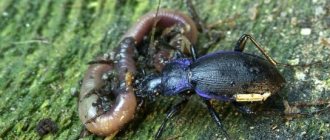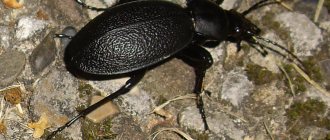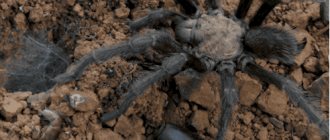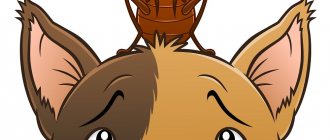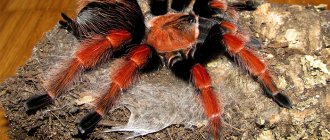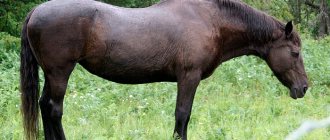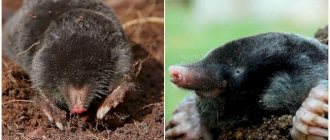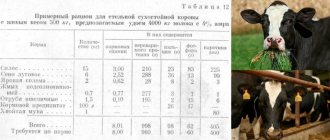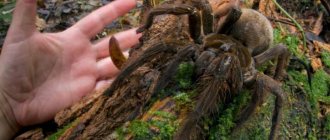The Crimean ground beetle is one of the largest and most beautiful predatory beetles living in the vast expanses of the Crimean peninsula. This species belongs to the ground beetle family, the order Coleoptera. The beetles are included in the Red Book due to a sharp decrease in their numbers. This is facilitated not only by the lack of precipitation, which affects the food supply of predators, but also by the reduction of virgin territories, as well as the use of pesticides and the catching of unique individuals by collectors.
Appearance
The graceful ground beetle has a body on which the head, chest and abdomen are oval in shape. The length of the beetle sometimes reaches 52 mm. This insect cannot fly - its wings are undeveloped, but its long legs allow it to run quite quickly. The front legs are adapted for cleaning the antennae due to the presence of a notch with dense hairs.
The Crimean ground beetle (photos of its representatives can be seen in the article) has several forms, differing in color, which can be blue, purple, green or black. The light on the surface of the coarse, wrinkled coatings is refracted, resulting in the illusion of the insect changing color. Experts call this feature optical coloring. The lower part of the ground beetle's body is black, with a shiny metallic tint.
Sexual demorphism is weakly expressed. Females are slightly larger, and males can be distinguished by their longer antennae and extended forelegs. The lifespan of these insects is 10-11 years.
Lifestyle and interesting facts about the Crimean ground beetle
The Crimean ground beetle is endemic to the Crimean peninsula.
Insects of this species are both diurnal and nocturnal. They feed on animal organisms. The main delicacy for the Crimean ground beetle is the grape snail. But the diet also includes other shellfish.
To feast on the meat of a mollusk, the ground beetle does not break the shell, but simply “sucks out” the body of the mollusk. When the ground beetle is completely saturated, it can burrow into the ground and remain motionless for several days. The endurance of the insect and its method of hunting deserve special attention. Thanks to its strong legs, the ground beetle can run about two kilometers in a night in search of prey!
The ground beetle can have different shades: from blue to black, including purple and green.
If the insect senses danger, it can release a sharp, caustic substance. For people, getting this composition into the eyes can cause conjunctivitis. This advantage makes the ground beetle not a very pleasant prey for birds and animals, so larger predators try to avoid this beetle. This applies to foxes, raccoon dogs, badgers and some birds.
Most often, ground beetles can be found in parks and gardens, where they spend time burrowing into fallen leaves. Sometimes these insects simply crawl along the ground, going about their daily business.
The ground beetle has no enemies in nature, thanks to its defense mechanism.
Ground beetles are considered one of the most useful beetles for agriculture. They are capable of eating harmful insects, such as silkworms, which annually cause massive damage to farmland. For this purpose, people specially release ground beetles into the fields.
Features of behavior
The Crimean ground beetle is a predator that most often leads a nocturnal lifestyle. Occasionally, it may appear during the day in search of food. Muscular long legs help hunt prey. With their help, the beetle also escapes from enemies. In one night, the insect can cover a distance of up to 2 km. At the same time, he has to maneuver to get to the most vulnerable spot of the victim. It is very difficult to catch a ground beetle - it is so evasive and fast.
When it is not possible to escape from the enemy with the help of its legs, it releases from its abdomen a stream of caustic brown liquid with an unpleasant, pungent odor. The formic acid contained in its composition causes severe pain and lacrimation if it gets into the eyes.
What does a ground beetle look like?
Crimean ground beetle (Carabus (Procerus) tauricus).
This representative of the ground beetle genus is a large predatory beetle. It belongs to the Coleopteran insects. The insect lives only within the territory of the peninsula.
The length of the beetle is about 5 centimeters.
The body length of the average adult Crimean ground beetle reaches 5.2 centimeters. The color of the ground beetle living in Crimea varies from blue to black. In this case, ground beetles of purple and green shades may be found.
Nutrition
Like most representatives of this family, the Crimean ground beetle has extraintestinal digestion. Holding its prey with its powerful jaws, the beetle practically sucks it in. The midgut secretions poured onto the victim help soften even the toughest tissues. Strong jaws easily destroy any chitinous cover.
The basis of the diet of ground beetles are caterpillars, slugs, snails, other beetles, and insect eggs. The predator can lie in wait for its prey in ambush or catch up with the help of long muscular legs. When eating a snail, the beetle leaves its house intact, gnawing only the mollusk itself. Having had enough, the Crimean ground beetle burrows into the soil for several days.
Security Notes
The species is listed in the Red Book of Ukraine (category III), and is included in the European Red List. It is protected in the reserves of Crimea. Conservation measures: Prohibition of the use of pesticides in habitats, prohibition of catching beetles.
Reproduction
Mating usually occurs in April. After this, the female lays eggs directly into the ground. Their depth is approximately 30 mm. There they remain for 13 to 14 days, after which larvae are born up to 19 mm in length and weighing about 160 mg. They have 6 claw-shaped short legs on their body. At first the larvae are white in color, but 10 hours after hatching they turn purple-black.
From birth they already have the powerful jaws of a predator. They feed on terrestrial mollusks, tightly clinging to them. The victim, resisting, covers the larva with mucus and foam, but it stubbornly fights off with its legs, burrowing into the soil and turning its shell towards itself. Then it gradually penetrates into it and eats the mollusk. By the end of summer, the development of the larvae is completed, it pupates and overwinters as an adult. This stage lasts from 2 to 3 years.
What does it eat?
The Crimean ground beetle is a carnivorous insect that feeds on terrestrial mollusks. The predator's diet includes:
- slugs;
- caterpillars;
- small beetles, their eggs and larvae.
The beetle's favorite delicacy is the grape snail. To eat a mollusk, the predator does not damage its shell; it places its head in its cavity and digs its powerful jaws into the meat of the prey, “drinking” it. A satiated ground beetle buries itself in the ground, where it can lie for several days.
On a note!
Crimean ground beetles bring great benefits to agricultural lands, protecting them from harmful insects.
Keeping at home
The insectarium must be decorated in such a way that it completely resembles a forest clearing. Turf soil along with grass, fallen leaves, moss and sand are placed at its bottom. Various stones and shards are also placed here, which will serve as shelter for the insect. Earthworms, slugs, cockroaches are suitable as food - this is what the Crimean ground beetle feeds in natural conditions.
The maintenance of larvae is not much different from the conditions for adult beetles. The main thing is that they are kept separate from them. Twice a day (morning and evening), the grass should be lightly sprayed with water to maintain the required humidity.
Ecology
Of all the abiotic factors, the main limiting environmental factor for the distribution of ground beetles is soil moisture. The vast majority of species prefer moist biotopes with low temperatures, which is due to the rapid loss of water by the body of ground beetles. This is especially true for predatory species that need to replenish their body’s water supply by directly drinking water. Phytophagous ground beetles replenish water shortages by eating plant tissues where there is enough plant sap. Some parasitoid species replenish the lack of water at the expense of the host's hemolymph. A small group of species has adapted to conserving water and is able to live in saline biotopes - the coasts of salt lakes, salt marshes, and sea beaches.
Purple ground beetle
Lebia the little crusader
Security measures
The number of this amazing insect is affected by the amount of precipitation, which is directly related to the food supply in the form of terrestrial mollusks. Cutting down vineyards leads to the disappearance of the grape snail, which is the main food of ground beetles. The reduction in numbers is also affected by the cultivation of forest clearings, the high sensitivity of this insect to pesticides, as well as uncontrolled fishing by collectors.
Today, the Crimean ground beetle is protected by law. In the Red Book it is listed as a rare, endangered species. In beetle habitats, there is a ban on the use of pesticides and the fishing of insects.
Enemies
Caucasian ground beetles are carnivorous predators; many species of ants and birds do not mind feasting on eggs, larvae and the beetles themselves. Many badgers and hedgehogs are a potential threat to this species. Caucasian beetles can become a snack for bears and wild pigs. However, the greatest pests for the development of the population are ants, which climb into the shelter of ground beetles and eat their larvae and eggs. Ants do not risk attacking adult individuals, since due to their small size they themselves will become a victim of the insect.
It is surprising that the Caucasian ground beetle feeds on many insect pests, so this representative has only a positive effect on the development of agricultural crops. However, many people do not realize this, so when they see this representative they try to immediately destroy it.
The population of the Caucasian ground beetle is under threat, and in order to prevent an even greater decline in the species, this species was included in the Red Book of Russia and Georgia.
Destructive flora: dangerous plants of Crimea
Is it dangerous to walk through the forests of Crimea? To a certain extent, yes, because on a walk you may come across beautiful and attractive plants that are considered poisonous.
- Crow's eye. A toxic plant, but its dark blue berries, similar to blueberries, are especially poisonous. If you eat such “beauty”, then severe poisoning is guaranteed.
Crow's eye is a poisonous plant, the fruits of which can be confused by both children and adults with blueberries.
- Yasenets (Burning Bush, Asterisk). The lilac or pink flowers of this plant cause severe skin burns within a few hours of touching it. The ash tree is not dangerous to the body, but after it heals, scars remain. Grows in all forests of Crimea.
Ash tree has a pleasant citrus aroma, but even inhaling the pollen of this plant can cause a burn to the respiratory organs.
- Aconite (wolf root, king potion). The plant with blue flowers grows in beech forests and is considered completely poisonous. Affects the central nervous system, causing convulsions and paralysis of the respiratory organs.
Aconite is unknowingly used to brew tea, which leads to severe headaches and hallucinations.
- Belladonna. A plant with a purple fruit like a small cherry. If you eat it, it begins to burn in your mouth, it becomes difficult to swallow, your heart rate increases, and hallucinations are possible. If a person is not helped in time, the outcome can be very unfavorable.
Belladonna berries, which look appetizing in appearance, taste like cherries, which is why children are often poisoned by this plant.
- Bollygolov. Looks like a parsley bush in the flowering stage. Both the leaves and fruits of this plant are dangerous - they paralyze muscles, legs, and the skin loses sensitivity. Respiratory paralysis is especially dangerous.
Hemlock venom can cause food poisoning, convulsions, and paralysis.
Elderberry, datura, Crimean wolf's bast, yew, and black henbane pose a certain danger. Poisonous plants grow everywhere, so before going into the forest it is advisable to ask local residents about them.
First aid for poisoning with poisonous plants : induce vomiting to cleanse the stomach, take activated charcoal, an antipyretic. In the case of black eye, vomiting cannot be induced; only the use of activated carbon is recommended. In the case of plants that cause skin burns, wash the affected area with soap and use anti-burn ointment.
Rating of the most dangerous roads in Crimea
- Serpentine on Ai-Petri. The path to this mountain is one of the most winding and lengthy on the peninsula. Driving on the road is very dangerous, even in clear weather.
- Boar Pass or Bichke Pass (Crimean Mountains, Baydar Valley). The road is quite difficult; you can only drive along it with a high-quality SUV.
- Belogorsk (42 km from Simferopol) - Privetnoye (Alushta). It is along this path that you can easily get to the South Coast, but even an SUV can hardly navigate the local dirt road. This is due to many cliffs and potholes.
- Sudak - Alushta. A beautiful route over 80 km long. But drivers hardly get to admire the local scenery, because the road is dotted with potholes, potholes, and sharp turns.
- Sudak - New World. The serpentine road is picturesque, but quite dangerous, with sharp turns and potholes.
[tp_hotel_widget hotel_id=28294584 responsive=true subid=””]
Dangerous places, areas and objects of Crimea
According to rescuers, the most dangerous places on the peninsula in 2016 were:
- Mount Ayu-Dag (near Partenit),
- Demerdzhi massif (between the Angarsk pass and Alushta),
- Grand Canyon (Crimean Mountains, Bakhchisarai region).
The most injuries were recorded in these places, as the most difficult tourist routes are located here.
As for objects, UNESCO named the Chersonese-Tavrichesky Museum-Reserve (Sevastopol) the most dangerous on the peninsula.
[tp_hotel_selections_widget id=6610 cat1=»3stars» cat2=»distance» cat3=»tophotels» type=full limit=10 subid=»»]
Dangerous marine inhabitants of Crimea
Stingray (sea cat). The fish loves sandy bottoms and shallow waters. In the area of her tail there is a poisonous spike, the injection of which causes a laceration. It hurts and doesn't heal for a long time. A person suffers from nausea and vomiting, a rapid heartbeat, and muscles are paralyzed.
First aid : wash the wound with fresh water, remove the thorn, wash the wound again with soap and water, apply a bandage.
The spine located on the tail of the stingray leaves a torn and deep wound on the human body.
Sea dragon. This brownish-yellow fish is easy to miss on the seabed. It is similar to a sea goby, the only difference being that it has a fin on its back, the venom of which is comparable to that of a snake. The injection site with such a fin swells greatly and hurts unbearably, and the temperature rises. The venom of the sea dragon is deadly, so the victim needs the help of a doctor.
First aid : remove the thorn, suck out the poison within 10 minutes after the injection, rinse the wound thoroughly with water, apply a tourniquet above the wound (loosen and tighten again every 10 minutes), immerse the limb in hot water with manganese for half an hour or simply treat the wound with peroxide hydrogen. Apply a bandage with an antiseptic, drink plenty of water, take a pain reliever.
Even a dead sea dragon can cause harm, so do not pick it up.
Sea urchin (scorpionfish). The fish swims close to the shore. Brown-brown, up to 20 cm in length, with large cloudy eyes, spines and spikes on the head, as well as a spiny fin on the back, the fish looks very scary. You should not pick up the ruff, as its spines are poisonous. Having been injected, a person will feel excruciating pain, weakness, and dizziness. Painful symptoms persist for 24 hours and then disappear.
First aid : The victim should be completely at rest. Remove the needles from the wound, immerse the limb in hot water (up to 45 degrees), treat the injection site and apply a bandage. Splinting and drinking plenty of fluids are recommended.
With its terrifying appearance and the poison on its spines, scorpionfish are very tasty, moreover, it is considered a delicacy.
